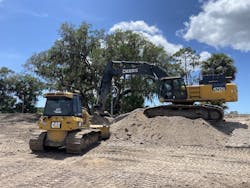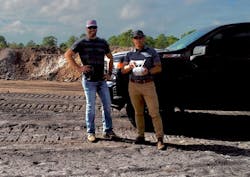Jonathan Shipps has been working for his family’s business, Shipps Contracting, for as long as he can remember.
Though his grandfather and father took a more traditional approach to doing business, Jonathan hoped to eventually compete for jobs on a much larger scale.
Jonathan is a member of the ninth class of Under 40 in Construction Equipment. These young people represent exciting potential for the industry.
Click to nominate someone into the next class of Under 40.
In 2017, when Jonathan began running Shipps operations himself out of Venice, Florida, he was able to do just that. He eventually made it his goal to grow the company and implement a technology-based workflow.
“I was an operator for my dad even through high school, and then a foreman and superintendent for him,” he says. “After I took over, I ramped it up and implemented technology like grade control. I was intrigued by it, and I wanted to grow the company.”
Today, under Jonathan’s direction, the business has quickly grown from an eight-person operation to a team of 32. The company focuses on complete site development, especially earthmoving and road work.
Shipps began using Trimble GPS grade control two years ago. With the sheer number of mass grading jobs the company works on, he says grade control allows the company to complete jobs quickly and efficiently.
“That’s been the biggest kicker for us to help our clients and for us to compete with bigger companies that may have, say, 110 or 120 employees,” he says. “We can knock out these jobs and compete with their schedules, and move more material more accurately everyday.”
Shipps says most of the larger roadwork companies and civil jobs are currently running GPS. He finds it difficult to be taken seriously by clients without it, especially on a large scale.
“Without GPS, we’d be the odd man out,” he says. “Clients know how much quicker you can get the work done if you’re running GPS. Our team may need four machines and a survey crew if you’re doing 3- or 4-foot fills or knocking stakes out, whereas with GPS we don’t have to keep re-staking. We check our blade, and we go to work.”
Since Shipps runs a mixed fleet, the team currently has Trimble GPS on its Caterpillar D5K2 LGP, D6K2 LGP, and D6N LGP dozers, and on a John Deere 700 dozer. Shipps says his machines need to be outfitted with GPS, which is usually installed by SITECH, Trimble’s dealership.
SITECH helps guide Shipps in using Trimble’s GPS systems and makes repairs to Trimble hardware as needed. The team also remotely monitors software to ensure it is continuously up and running.
“If I have an issue with a valve or any wires breaking off, I just call them up,” Shipps says. “My rep is Cory Baker; I’ve known him [personally] for 13 years now, and those guys are always on it for us. You’re only as good as what your support is.”
Baker has been a representative at SITECH North and Central Florida for a little over two years. He and the Shipps team often collaborate to produce the 3D Grade Control models the dozers reference using Trimble Business Center (TBC), Trimble’s in-office software.
Baker describes TBC as “the hub in the wheel”...all Trimble technology feeds off of it and connects with Shipps machines.
“Once a Shipps engineer has finished creating a conceptual layout for the project in the office, a guy will go out with the Trimble survey equipment to verify existing plan elevations,” Baker says. “At that point, Jonathan is confident in mobilizing onto the site, and producing the 3D CAD model.
“This allows us to take plans and the engineer’s CAD files (digital files that house 3D and 2D designs)—essentially everything from the office side—and push them out into the field,” Baker says. “Because the equipment is no good without data.”
This is particularly helpful in Florida, where the Shipps team grades a number of lake banks and roadways. Shipps says with certain subdivisions and commercial work, there is only a “1.2-inch grading tolerance” allowed.
“If they tell us the top of a lake bank needs to be a grade of 25.3, it has to be either a 25.2 or 25.4”, he says. “It has to be within an inch of what they’re asking for when the grade is done, or they’ll make you fix it. So it’s good to make sure our equipment is as tight and accurate as it can be, because it’ll save us a lot of rework.”
Grade control also helps prevent unnecessary wear and tear on Shipp’s machines, extending their lifespan.
“[As an example], a costly item on a dozer is the undercarriage,” he says. “The more miles and the more time you spend making passses on a slope, and the faster you’re making passes on a lake bank—it wears your undercarriage out and raises your operating costs.
“Even if I had my best operator making four passes to put a finish on a lake bank without grade control—if I put a beginner operator in a machine with grade control and he can finish that in one pass, technically I just cut my operating costs by 75 percent versus the four passes with my best guy.”
According to Baker, all machines running Trimble software also have a Trimble modem connected to them. This cellular device allows SITECH dealers to pull up diagnostics on all of the machine’s Trimble components in the event of a failure.
“The modem tells us if the technology is connected and functioning,” he says. “We can also go into some of those components—especially the receivers that are communicating to the satellites—to see how well they’re communicating. Just because they’re functioning doesn’t mean they’re functioning to their absolute potential.”
Baker can also remotely view machine displays.
“Usually we’ll log in to the display and we’ll see what job site they’re on, what data set or 3D model they’re utilizing, the elevation of the blade,” he says. “All of that kind of ‘speaks’ to us if there’s an issue with the software.”
SITECH can also assist in remotely troubleshooting if there is a tech issue on the job, aiming to keep the team on schedule.
Above: Jonathan Shipps (left) with Cory Baker, his SITECH rep and friend.
“Sometimes we’ll have guys out grading on site per the 3D model, and a surveyor has some grade stakes out,” Baker says. “If they pull up and say ‘man, these stakes don’t seem to make sense,’ we can login to the machine, see what file revision they’re using, and check design elevation on that. Then we can look back at the machine, see what live elevation they’re running on, and do a quality-control type of comparison to let them know what they’re seeing on site—if the machine is good, or the stake is good.”
If a piece of Trimble equipment goes down is in need of repair, Shipps says he’ll reach out to Baker or one of SITECH’s field technicians. He also utilizes Trimble’s Protection Plan and remote access capabilities, which keep him supported with production equipment and day-to-day operations.
“If I have an issue with my TD520 display in the dozer—maybe it’s not updating or it’s shutting down—I get a hold of SITECH,” he says. “Or if one of the guys rips a wire off the blade, SITECH will send techs out to the field. If I need extra parts, rovers, or a base station—really anything I need on the technology side—that’s who I go to.”
When a machine is no longer worth repairing, Shipps tries to rotate it out—especially if it’s a main finish-grade dozer. This usually occurs at the 5,000 to 6,000 hour mark, he says. Because of this, he also finds Trimble’s grade control plug-and-play aspect especially convenient, allowing the ability to move the program from one machine to the next.
“If you run that dozer for three years and you trade it in, you can pull the GPS system off and put it on your next dozer,” he says. “This is really nice for us because we try to switch out our grading equipment every three years and get fresher machines if need be.”
Shipps plans to expose his company to even more technology. He is currently in the process of incorporating more Trimble software, including estimating.
“There’s a big learning curve, so nothing is set up and running yet,” he says. “We’re trying to figure out what we can pick and choose, what’s going to benefit us the most from where we’re at. We’ve already got so much GPS going on, we’re just trying to figure out ways to make it more streamlined.”
Shipps also hopes to implement software that will more accurately track a project’s duration. If there’s any way to make the process more seamless through technology, he’s in.
“The technology definitely paid off,” he says. “Now I have [clients] who believe in us, who will give us an opportunity, and really good guys around me.”
About the Author
Gianna Annunzio
Gianna was associate editor from 2018 - 2021.


